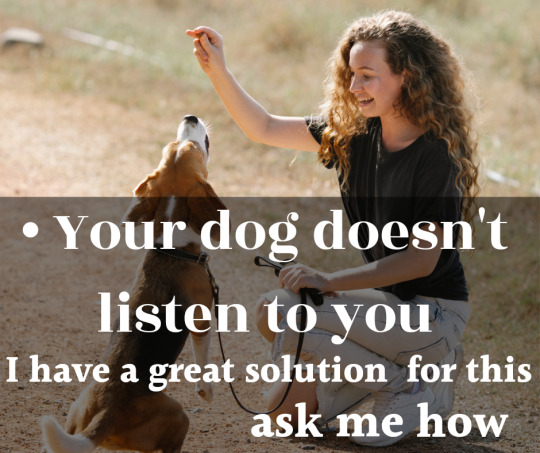#realitydogtraining
Text
Solving Dog Problems

Have you ever been enjoying a walk with your dog when suddenly you are almost tripped by Fido or Fifi unexpectedly crossing in front of you? Not only is it unpleasant, but crossing in front of you like this is dangerous for both you and your dog. Luckily it is fairly easy to teach your dog to stay on one side of you and not to switch sides.
I feel that it is works best to teach your dog leash manners when using a 6 foot leash (not a Flexi-type) and a no-pull harness if your dog pulls.
The first thing to do is decide which side of you that you would like your dog to walk. Then, as your dog is walking on the leash reward him any time he happens to be on your chosen side by saying "yes" or "good" and feeding him a treat right by your side.
Be very careful to feed the treat by your side and not to feed the treat in front of you as that will encourage crossing in front.
While walking your dog, be careful to watch him, and as soon as he starts to cross in front of you, use your leash to prevent him from crossing, and stomp your feet to make your presence known.
Consistently rewarding your dog for being on your preferred side and preventing him from crossing in front by using the leash and by stomping your feet should help teach your dog to stop crossing in front of you and lead to safer and more pleasant walks. Enjoy!
Click here for more ---Click here tips on training
#dogtrainer#dogtraining#zakgeorge#dogtrainingrevolution#positivedogtraining#balanceddogtraining#forcefreedogtraining#dogtraining101#puppytraining#puppytrainingadvice#puppytrainingtips#puppytraining101#realitydogtraining#dogtrainingadvice#dogtrainingtips#howtotrainyourdog#dogsofinstagram#dogstagram#ilovemydog#dog#dog training#cute dog#doglover#doglife
2 notes
·
View notes
Text
How Should You Train Your Dog?
There are two common methods of training a dog.

Clice here to train your dog
The first is the aversive-based method. The second is the reward-based method. Aversive-based (discipline) training is when you use positive punishment and negative reinforcement techniques with your dog. Reward-based methods use rewards only for the behaviors that you want your dog to follow.
Aversive-based training uses techniques like loud, unpleasant noises, physical corrections, and harsh scoldings to get your dog to act the way you want. On the other hand, reward-based training uses rewards whenever your dog does something you want it to do. Treats, belly rubs, or other dog-pleasing actions are used to reinforce that a behavior was good.
Different experts prefer one method over the other. The one that you use is completely up to you.
Some people believe that a rewards-based method sets up an "event sequence" for your dog where they associate you with happy feelings when they do what they're told. Aversive-based methods do just the opposite, where they fear you. That fear means that your dog does what they are told to avoid unpleasant feelings.
Learn more click here
#fosterdog#rescuedog#dogtrainingrevolution#zakgeorge#dogtrainingexperience#realitydogtraining#dogtrainingrevealed#dogtraining#positivedogtraining#pitbulltype#pitbulltraining#pitbull#rescuedogsofinstagram#rescuedogtraining#shelterdogtraining#animalrescue#dogsofinstagram#trainwithoutpain#YouTube#youtuber#puppytraining#puppiesofinstagram#leashpulling#obediencetraining#newdog#newpuppysurvivalguide#newdogsurvivalguide#dogtraininghelp#ilovedogs
1 note
·
View note
Text
The danger in working on this is if your dog doesn't get the treat right away, she may get more frustrated and grab harder for it the next time.
If you use the technique I will describe, to avoid getting your dog frustrated you will want to start with feeding her the treat for all but the most rough grabs (say one in 5) and then gradually start getting pickier as she improves.
This will go faster if you feed her kibble by hand (no tricks required) using the following technique:
Get her food bowl with kibble in it.
Hold out a piece of kibble in a way that you can keep it if she bites down hard.
If she mouths hard say "ouch" and put the kibble back in the bowl and put the bowl up for a minute or two.
Repeat Repeat Repeat.
Make sure you are not doing the ouch routine for more than 1 in 5 times of offering the kibble.
Begin to get more and more sensitive (making sure that she gets the treat 4 out of 5 times still).
Once she is doing great for this, try working on it in other contexts.
While you are working on this with her food bowl, I suggest that for training and other times you feed treats, deliver the treat in a way that will just avoid the possibility of her mouthing you hard (toss it perhaps) until you are getting progress with her meal.
#fosterdog#rescuedog#dogtrainingrevolution#zakgeorge#dogtrainingexperience#realitydogtraining#dogtrainingrevealed#dogtraining#positivedogtraining#pitbulltype#pitbulltraining#pitbull#rescuedogsofinstagram#rescuedogtraining#shelterdogtraining#animalrescue#dogsofinstagram#trainwithoutpain#YouTube#youtuber#puppytraining#puppiesofinstagram#leashpulling#obediencetraining#newdog#newpuppysurvivalguide#newdogsurvivalguide#dogtraininghelp#ilovedogs
1 note
·
View note
Text
Dog Training: Obedience Training for Dogs
Most people love their furry companions. However, not every moment is enjoyable when your dog isn't trained to behave in specific ways or avoid unwanted behaviors.
There are many techniques passed on from unknown sources that tell you the best ways to get your dog not to do something. But what is the best method, and how do you use these techniques?
Learn the most common methods for how to train your dog, as well as what techniques not to use.
How Should You Train Your Dog?
There are two common methods of training a dog.
The first is the aversive-based method. The second is the reward-based method. Aversive-based (discipline) training is when you use positive punishment and negative reinforcement techniques with your dog. Reward-based methods use rewards only for the behaviors that you want your dog to follow.
Aversive-based training uses techniques like loud, unpleasant noises, physical corrections, and harsh scoldings to get your dog to act the way you want. On the other hand, reward-based training uses rewards whenever your dog does something you want it to do. Treats, belly rubs, or other dog-pleasing actions are used to reinforce that a behavior was good.
Some people believe that a rewards-based method sets up an "event sequence" for your dog where they associate you with happy feelings when they do what they're told. Aversive-based methods do just the opposite, where they fear you. That fear means that your dog does what they are told to avoid unpleasant feelings.
Understand How Your Dog Learns
Dogs learn a lot like little kids. They are close in intelligence to human two-year-olds. Immediate consequences are all that they care about. As they grow, they begin to understand our words. Some intelligent breeds will respond to as many as 250! Yet every dog responds to the tone of our voice more than the actual words.
There are three types of dog intelligence recognized by scientists:
Instinctive
Adaptive
Working and obedience
Instinctive learning is when your dog learns the behaviors they were bred. Adaptive learning is how well your dog learns from their surroundings and the environment around them to solve problems. Working and obedience are how well they learn the tasks and commands that you teach them.
To get your dog to be obedient, you should focus on training that uses obedience techniques and the specific behaviors you want from them. Both aversive- and reward-based training have been proven to work. However, if you’re training your dog to be a loving pet, you should consider reward-based obedience training. This method doesn’t develop fear-based responses in your dog. It actually reinforces your loving relationship with them.
LEARN MORE CLICK HERE
#dogtraining puppytraining rescuepuppy fosterpuppy adoptme zakgeorge realitydogtraining dogtrainingrevolution newpuppysurvivalgui#doglover doglovers dogloversofinstagram dogloversfeed dogloversclub dogloversonly Dogloverindonesia dogloverstagram doglover
2 notes
·
View notes
Text
Dog training

A rewarding part of dog ownership is successfully training your dog. Training is an excellent way to bond with your dog and will help you build a good relationship with them.
Whether young or old - all dogs can benefit from learning some basic commands. Our guides can help you with the basics of how to train your dog but we also recommend dog training classes, especially for more advanced methods such as clicker training.
A qualified behaviourist specialises in helping behavioural issues such as excessive barking, aggression, destructiveness and phobias. A dog training instructor helps owners train their pets, or teaches them to work with an animal trained to do a specific task.
If the basics such as sit, down, stay and leave are what you're looking for - look no further...
What are the benefits of training my dog?
Teaching your dog basic obedience like sit, wait and coming back when called gives them the freedom to do the things they like to do, like running off lead and coming with you to meet friends and family, while being safe and under control.
Dogs are intelligent animals and most love to learn so training can be a great way of stopping them from getting bored.
Learn More Click here
2 notes
·
View notes